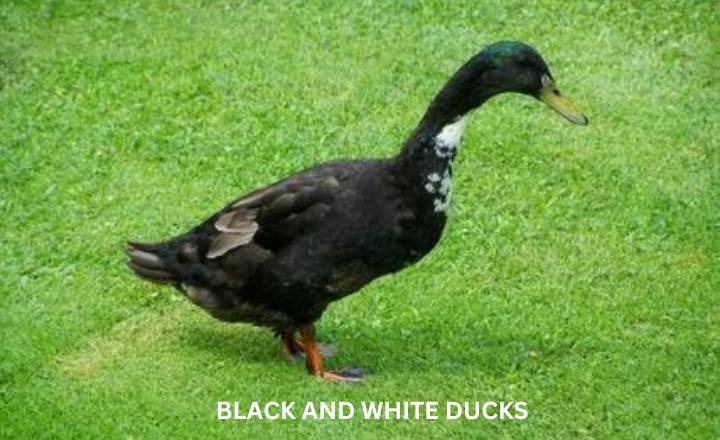In a world where vibrant feathers often steal the spotlight, a quaint group of ducks dressed in traditional black and white stand out from the crowd. These seven black and white duck breeds captivate waterfowl admirers with their distinctive personalities and eye-catching patterns.
Among the variety of duck breeds with stunning black and white plumage, these striking birds not only enhance the visual appeal of any flock but also boast unique personalities and traits that set them apart. Join us as we explore seven exceptional breeds of black and white ducks, sure to charm you with their beauty and individuality.
1. Muscovy Duck
The Muscovy duck fascinates bird enthusiasts worldwide with its unique appearance and behavior. Native to Mexico and Central/South America, Muscovy ducks are distinguished by their iridescent feathers and red facial caruncle. Unlike other duck species, Muscovy ducks often perch on trees or roost in high areas, relying less on water for survival.
Once found only in specific regions such as the Big Island of Hawaii, Florida, Louisiana, Texas, the Rio Grande Valley, and Massachusetts, Muscovy ducks have now spread to Australia, New Zealand, and Europe.
2. Hooded Merganser
Despite its modest appearance, the Hooded Merganser stands out due to its remarkable look and unique behavior. These birds are easily identifiable in the wild by their characteristic hood-like crest, which is black and white. Hooded Mergansers prefer wooded swamps and ponds with abundant foliage, making them an intriguing subject for birdwatchers due to their secretive nature and preference for isolated settings.
3. Greater Scaup
Also known as the bluebill, the Greater Scaup is a fascinating species found in North America. Male birds have glossy black plumage and bright yellow eyes, while females have slightly lighter feathers with a white patch near their bill.
Greater Scaup are skilled divers, reaching depths of up to 30 feet to search for marine life and invertebrates. Despite their diving prowess, pollution and habitat loss pose significant threats to their populations, making conservation efforts crucial for their survival.
4. Wood Duck
The Wood Duck is renowned for its vibrant and colorful plumage, especially in males, with iridescent green, purple, and white shades. Found across North America, these ducks have seen a resurgence in population due to conservation initiatives. Wood Ducks nest in cavities, often using abandoned tree holes or man-made nest boxes near water.
The female Wood Duck has more muted colors and a mottled brown appearance, providing camouflage during the nesting season. Their beauty and ecological significance make them a beloved symbol of wetland preservation in North America.
5. Bufflehead Duck
Bufflehead ducks are small, agile divers with distinctive white patches on their dark bodies and large, bulbous heads. They forage for small fish, crustaceans, and insect larvae underwater. Male Buffleheads perform elaborate courtship displays involving diving and wing flapping to attract mates.
These monogamous birds form enduring pair bonds and both parents actively participate in raising their young. Their adaptability to various environments, from freshwater lakes to coastal marshes, is a testament to their resilience.
6. Tufted Duck
Tufted ducks are characterized by their bright yellow eyes and distinctive black and white plumage. Found in aquatic habitats across Europe and Asia, they dive deep for food, including aquatic plants and crustaceans. Known for their resilience, tufted ducks thrive in both freshwater lakes and coastal environments.
Their courtship displays involve intricate head bobbing motions and vocalizations. During the breeding season, males often engage in aggressive confrontations with rivals, showcasing the elaborate evolutionary designs in nature.
7. Common Goldeneye Duck
The Common Goldeneye is found in freshwater lakes and rivers across North America. Distinguished by their bright yellow eyes and striking black-and-white coloration, they perform elaborate courtship displays during the breeding season. Males exhibit head-throwing motions and whistling calls to attract females.
Common Goldeneyes are expert divers, reaching depths of up to 100 feet in pursuit of small fish and aquatic invertebrates. Their streamlined bodies and webbed feet allow them to navigate waterways swiftly in search of food.
Frequently Asked Questions
What do ducks eat? In their natural habitat, ducks consume a variety of aquatic vegetation, insects, tiny fish, and algae. While they can occasionally enjoy fruits like grapes or berries, these should not be their main diet.
How long do ducks live? Wild ducks generally have a lifespan of 2 to 5 years, while domestic ducks can live between 8 to 12 years on average.
What should you feed ducks? Healthy options include cracked corn, oats, peas, lettuce, and chopped vegetables. Avoid feeding ducks avocado, chocolate, onions, garlic, and caffeine as they are toxic to them.
Why do people put ducks on jeeps? As a symbol of off-road adventure and community among Jeep enthusiasts, people mount rubber ducks on their vehicles, a tradition thought to have originated with soldiers attaching them to military vehicles for good luck.
What do baby ducks eat? Baby ducks should be fed specialized duck starter feed or crumbles. They also benefit from insects and worms as a protein source, and can safely enjoy watermelon and lettuce in moderation.
What is a group of ducks called? A group of ducks is commonly called a flock or a team. Specific terms include a brace of mallards, a raft of diving ducks, and a sord of teal.
When do ducks start laying eggs? Ducks typically start laying eggs around 5-7 months old. Depending on the breed and individual, a duck can lay about 100-300 eggs per year.
What does duck taste like? Duck meat is often described as having a more robust and flavorful taste compared to chicken, with a slightly earthy aroma while cooking, adding to its unique flavor profile.




